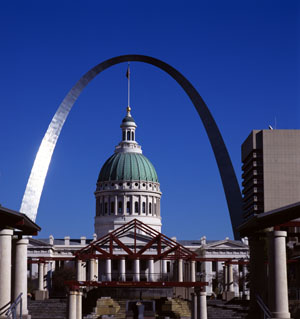
Four architecture professors from the Sam Fox School of Design & Visual Arts are part of two teams that have reached the second round of an international competition to reshape the grounds surrounding St. Louis’ iconic Gateway Arch.
The competition, titled “Framing a Modern Masterpiece: The City * The Arch * The River,” was launched last December by the CityRiverArch 2015 Foundation, a new local group that is working with the National Parks Service and the City of St. Louis. The competition aims to reinvigorate the 91-acre site by improving connections and transitions between the Arch grounds, downtown St. Louis and the Mississippi Riverfront.
Entrants included 49 teams representing eight countries. Of those, nine teams have advanced to the second round.
Paul Donnelly, the Rebecca and John Voyles Chair in Architecture, is part of a group submission by the FIT (Fully Integrated Thinking) Team, which also includes Cecil Balmond-ArupAGU, Doug Aitken Studio, HOK Planning Group and HOK.
A second team includes three faculty: Christof Jantzen, I-CARES professor of architecture; Peter MacKeith, associate dean of the Sam Fox School of Design & Visual Arts and associate professor of architecture; and Eric Mumford, Ph.D., professor of architecture. Jantzen, who arrived at the Sam Fox School last fall, is a partner with Behnisch Architekten, which is serving as lead designer for the team. The firm is known internationally for its work in sustainable and ecologically responsible architecture.
Rounding out the Behnisch Architekten team is a handful of additional firms and practitioners representing the fields of architecture, landscape architecture, urban design, engineering and art. These include Gehl Architects, Stephen Stimson Associates, Buro Happold, Transsolar Applied Ecological Services, Limno-Tech, Herbert Dreiseitl and Arne Quinze.
“The complexity of the task requires a multitude of perspectives,” MacKeith says. “By necessity, it includes historical perspectives, environmental perspectives, geological and hydrological perspectives, infrastructure and other systems. Indeed, though it may be difficult — or even presumptuous — to imagine an absolutely comprehensive proposal, the circumstances encourage such thinking in order to address the dynamics of the landscape as well as the opportunities of the city and region.”
Few are more familiar with the history and development of the Arch grounds than MacKeith and Mumford. MacKeith served as St. Louis coordinator for “Eero Saarinen: Shaping the Future,” a major touring retrospective that traveled to the university’s Mildred Lane Kemper Art Museum last spring. The exhibition was the first to explore the complete career of Eero Saarinen (1910-1961), who designed the Arch in 1947-48 as part of the Jefferson National Expansion Memorial (JNEM) Competition.
In conjunction with “Shaping the Future,” MacKeith and Mumford also organized “On the Riverfront: St. Louis and the Gateway Arch,” an exhibition and symposium focusing on the people, events and circumstances that shaped the JNEM Competition as well as Saarinen’s winning design.
“Saarinen’s original scheme included an entire park complex on the Illinois side of the river,” Mumford says. “But for various reasons, which are very complicated, it was never built. In a way, the new competition is simply fulfilling Saarinen’s vision for the site.
“Today, I think there’s a general sense that the St. Louis waterfront, compared to those of other cities, is underutilized,” Mumford says. “The Mississippi River system is a great environmental and historical resource — it’s the reason that St. Louis is located here, at this key juncture — but it’s largely cut off from downtown.
“Right now, it can feel like an industrial canal.”
Two additional WUSTL faculty are playing significant roles in “The City * The Arch * The River.” The eight-person competition jury, which will select the final design, includes Gerald Early, Ph.D., the Merle Kling Professor of Modern Letters and director of the African and African-American Studies Program and the Center for the Humanities, both in Arts & Sciences.
Bruce Lindsey, dean of architecture and the E. Desmond Lee Professor for Community Collaboration, sits on a governance group established by the CityArchRiver 2015 Foundation.
The competition itself is unfolding in three stages:
• Stage I consisted of portfolio submissions, including a description of the design team; a statement of design intent and the philosophy of the lead designer; a profile of the design team; and examples of their work.
• Stage II involves the formation of the complete teams capable of executing the project; submission of required paperwork; and a jury interview. This phase will culminate April 7, with the narrowing of the field to four or five teams.
• The final stage, Stage III, will take place over the summer and will include a 90‐day design concept competition to explore the finalists’ design approach and to test their working methodology.
The winning submission will be announced Sept. 24. Organizers hope to complete construction by Oct. 28, 2015 — the 50th anniversary of the completion of the Arch.
For additional information of a complete list of Stage II participants, visit cityarchrivercompetition.org.